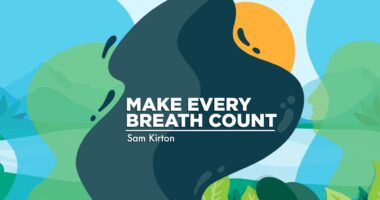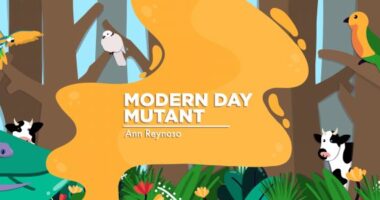A family road trip reminded me that there is life after diagnosis
My husband had just been diagnosed with PF, and I was worried

Less than a year after my husband, Donnie, was diagnosed with pulmonary fibrosis, we decided to take a road trip to the suburbs of Denver to attend a memorial service for a close family friend. His family had invited us to stay for a few days, and we decided we wanted to make the trip to pay our respects.
Understandably, I was a little nervous, as it was our first extended trip with supplemental oxygen. At our home in the rural Midwest, the elevation is about 750 feet above sea level. Denver is over 5,200 feet, and we didn’t know how the increased elevation would affect my husband’s breathing.
As we packed for our trip, I found myself anxious about the journey. Would Donnie have extra trouble breathing on the trip? What if his portable oxygen concentrator malfunctioned? What if we got stranded due to car troubles? I racked my brain trying to think of everything to pack.
The departure date eventually arrived, and we loaded our bags, the home oxygen concentrator, and the rest of his equipment into the car and headed for Colorado.
Finally living again
As we crept through Kansas, I became hyperaware of the slow changes in elevation. The towns were fewer and farther apart, and I grew anxious about the possibility of a medical emergency. I’d forgotten how vast the West is, and the isolation made me feel uneasy. I needn’t have worried, though, because we made it across the state without any problems.
About an hour before we arrived in Colorado Springs (elevation 6,033 feet), my husband began experiencing shortness of breath. We checked his oxygen, and his saturation was indeed lower than usual. At home, he typically only needs supplemental oxygen with activity and while sleeping, but with this revelation, we knew he would need to use his supplemental oxygen the entire time we were at a higher elevation.
We made sure to keep his machine plugged in and a backup battery charged at all times. This part was the most unnerving, as we were concerned the machine might overheat, but thankfully, it performed well under pressure. Although we didn’t bring backup oxygen tanks on this trip, we will definitely pack some next time, if only for peace of mind.
Our first tourist stop was at the Garden of the Gods. The red rocks were gorgeous, and although we didn’t spend much time there, we managed to snap a few family photos and were glad to have experienced it together.

We spent our evenings enjoying gorgeous sunsets and beautiful weather in the suburbs of Denver, Colorado. (Photo by Kylene Henderson)
A year earlier, travel had been entirely out of the picture, and this trip was a massive milestone for us. We spent the next few days with our family friends, reminiscing, laughing, and telling stories that helped to ease the pain of loss. The memorial service was a beautiful tribute, and we felt so fortunate to be able to pay our respects. In the evenings, we enjoyed beautiful mountain sunsets, playing with our daughters at the park, and shooting hoops at a nearby basketball court.
For the last leg of our trip, we drove up to Laramie, Wyoming (elevation 7,200 feet), to show our daughters the town my husband had lived in for a while when he was younger. The view was magnificent, and the terrain provided a beautiful backdrop for our drive.
On the way out of town, we stopped at the Abraham Lincoln Memorial Monument on Interstate 80. The monument rests on the highest point of the transcontinental highway (elevation 8,640 feet). As the girls and I jumped out of the car to walk to the landmark, we quickly realized the air was thin, and we were a bit breathless. With his oxygen cranked up, Donnie was breathing more comfortably than we were!
When we returned home a couple of days later, Donnie and I felt a sense of accomplishment. While our trip had a few road bumps, we were so thankful that we were able to take the journey, challenge our comfort zone, say our goodbyes to our family friend, and make some lifelong memories with our daughters.
Of course, it had been of utmost importance to be mindful of the elevation changes and Donnie’s increasing oxygen needs, but for the first time in two years, I felt like we were finally living again. It was the reminder our family needed that life doesn’t end with a diagnosis. We’ve been able to take a few more road trips since then, and we look forward to many more adventures together as a family.
Note: Pulmonary Fibrosis News is strictly a news and information website about the disease. It does not provide medical advice, diagnosis, or treatment. This content is not intended to be a substitute for professional medical advice, diagnosis, or treatment. Always seek the advice of your physician or other qualified health provider with any questions you may have regarding a medical condition. Never disregard professional medical advice or delay in seeking it because of something you have read on this website. The opinions expressed in this column are not those of Pulmonary Fibrosis News or its parent company, Bionews, and are intended to spark discussion about issues pertaining to pulmonary fibrosis.








Tony Arrigo
Kylene, your essay on travel rang true . I have IPF and have gone through the throes of “I’m dying from this” and “I’m living with this”. Your road trip was the wise decision. Do what you can comfortably as long as you can. BTW, your preparedness was excellent. Inspiring essay !
Kylene Henderson
Thank you, Tony! I'm so glad we went, and travel doesn't seem quite as daunting now. We'd like to go on another road trip next year, but we'll see what summer brings!
Tony Arrigo
I’m 78 and was diagnosed in April 2020. My Pulmonologist ordered Jascayd for me to slow down the IPF progression. I need my portable oxygenator when walking . How old is your husband and when diagnosed ? We are all different . I’ve lost about 40 lbs in the last year off my 160 lb. frame. Thx again for the road trip, very inspiring .
Kylene Henderson
My husband was 37 when he was formally diagnosed, but he was having symptoms for over a year beforehand. His pulmonary fibrosis was caused by autoimmune diseases that he didn't know he had, but he takes medicine to help with that now, along with Ofev. He's done really well so far, but she said we will talk about Jascayd in the near future. Wishing you the best of luck, and I'd love to hear about your experience!
Tony Arrigo
Wow, 37 that is so young as the diagnosis is usually with those in their 60’s and 70’s. Good that he is responding well to OFEV. I too had a marker for an auto immune disorder but it hasn’t been traced to any health issue. I’m a Vietnam Vet and there is a chance it came from Agent Orange, Jet engine exhaust (I was a Crew Chief on Jet Fighters for 4 yrs in the USAF 1965-69) or combinations of both with other environmental factors such as asbestos, dry cleaning chemicals (I worked in a Dry Cleaner during High School) and cigarettes which I smoked from 17-37
Yrs old. I guess that’s why it’s called idiopathic, hard to point to one specific cause. I tried OFEV and didn’t tolerate it. I will keep you informed as to my tolerance for Jascayd. As you are learning, this disease manifests itself differently for all . Wishing your husband the best . Thx again for your courtesy and sharing .